Music
|
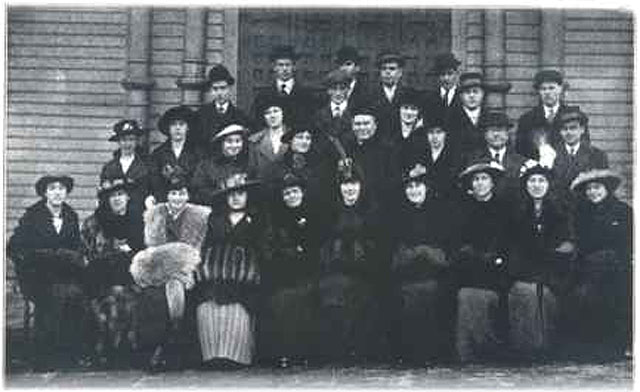 |
Choir - 1914
|
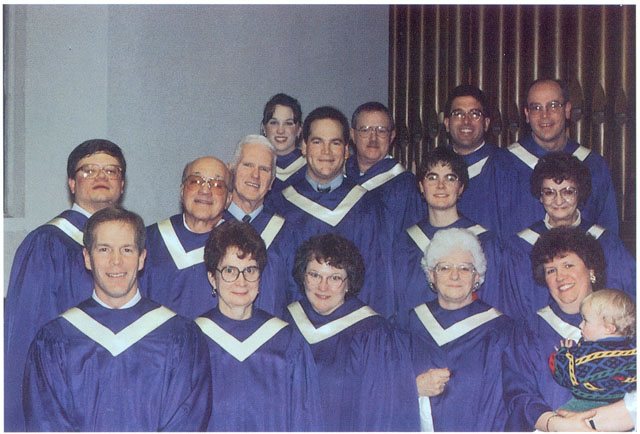
|
Choir - 1997
|
Gregorian Chant
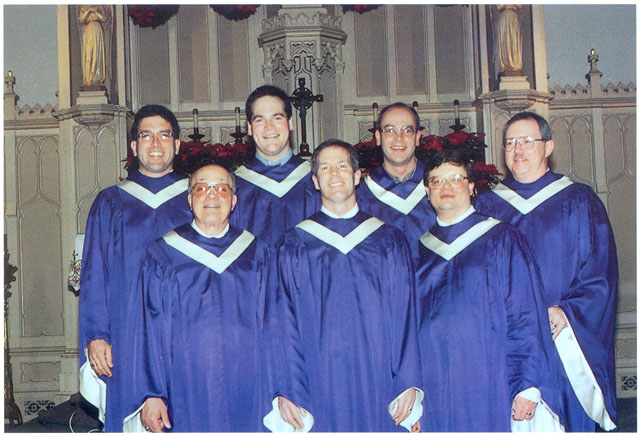
|
Gregorian Chant Schola - 1997
|
Gregorian Chant is the
liturgical chant of the Roman Catholic Church, and is named after Pope
St. Gregory I (“The Great”), who reigned from 590 to 604. One
traces its roots to the Jewish synagogue; one notes a strong Jewish
influence in many early chant texts that are taken from the
psalms. Moreover, the Church’s Hours of Prayer (The Office) are
modeled after the prayer hours of the Jewish synagogue.
Early development of Gregorian Chant took place in the East, especially
Jerusalem and Antioch. During the reign of Pope Damasus I, who
reigned from 366 to 384, the center of chant’s development shifted to
Rome. He was the first of the popes to start a chant cycle for
the liturgical year. Pope St. Gregory did much to organize
chant. Under him the type of chanting was fixed for centuries to
come. Legend has it that he was actually instructed by the angels
in the methods of chant. From the 14th to the 19th centuries the
melodies and rhythmic interpretations of chant began to
deteriorate. At the same time, we note an increase in the
prevalence of polyphonic music settings (hymns, and parts of the Mass).
The return to the correct medieval interpretations of Gregorian Chant
is due largely to the Benedictine Monks of Solesmes, France,
particularly Dom Gueranger. The process began in 1833 at a time
when each diocese in France had its own books for the celebration of
the Mass, none of which were approved by Rome; Solesmes was alone in
celebrating the approved Roman Rite. Dom Gueranger realized that
any restoration must begin with chant, for it is the authentic
expression of the texts of the Latin Liturgy. In 1904 Pope St.
Pius X issued his Motu Proprio
in which he declared that the Gregorian
melodies were to be restored in their integrity and identity after the
authority of the original manuscripts.
Today the restoration process of Gregorian Chant goes on at Solesmes,
and the papacy has directed them to produce all of the official revised
chant books. An example of a recently released book is the
Gregorian Missal (released in 1990) which includes all chants and
prayers, in both Latin and English, for the Masses on Sundays and
Holydays, according to the new and revised rites.
In the 1960’s Gregorian Chant was largely abandoned due to incorrect
and faulty personal interpretations of Vatican II by liturgists and
diocesan liturgy committees and commissions. Vatican II’s Constitution
on Sacred Liturgy, dealing with sacred music, said that Gregorian Chant
is to have “pride of place” in the Catholic Liturgy and the people are
to be taught chant. In April of 1974 the Sacred Congregation for
Divine Worship sent a letter and a copy of Jubilate Deo (a small
booklet of Gregorian Chant, organized by Pope Paul VI, containing a
minimum selection of chants that each parish should be able to sing) to
every bishop in the world. The letter explained to liturgists how
to give it the pride of place it demands, and how to teach it in each
parish. The following is a quote from the new Catechism of the
Catholic Church. “The musical tradition of the universal church
has created a treasury of inestimable value which surpasses the other
arts, owing above all to the fact that, as sacred song joined to words,
it comprises a necessary or integral part of solemn liturgy.”
(Sacrosanctum Concilium)
We, at St. John’s, are attempting to follow the wishes of the Vatican,
and its Sacred Congregation for Divine Worship. The large choir,
under the direction of Mary Smisek, sings the Kyrie, Sanctus, and Agnus
Dei, from the Jubilate Deo, each Advent and Lent at the 9:00 a.m. Mass
on Sunday, as well as various chant hymns. Also the parts of the
Benediction of the Blessed Sacrament are sung in Latin. Most
importantly, St. John’s has been truly blessed to have had pastors, in
Frs. Fink, Dolan and Welzbacher, who have promoted sound, orthodox
liturgies and
good music in accordance with the desires of the Vatican.
This fall the Gregorian Chant Schola at St. John’s will begin its
eighteenth year together as a group. It consists very
dedicated and talented men who are also members of
the large choir. As its leader, I grew up singing chant. At
St. Bridget’s Grade School, in Minneapolis, in the 1960’s, the good
Sisters of St. Benedict taught Gregorian Chant to the students.
Each Friday, at the school Mass, the entire school would gather and
sing The Mass of The Angels (VIII). Also, each class would take
turns singing the Gregorian Chant Requiem Mass at funerals. More
recently I have been a member and substitute conductor of the St. Agnes
Chant Schola. I am much indebted to its leader, Mr. Paul LeVoir, and
the former pastor of St. Agnes, Msgr. Richard J. Schuler, for the
wealth of
knowledge I have acquired about chant.
The Gregorian Chant Schola’s schedule of singing at St. John’s is as
follows. We sing at the 9:00 a.m. Mass on alternate Sundays.
We are very much open to new members, and extend an invitation to any
men who would be interested in joining us. If you are interested
please contact the St. John’s rectory at 651-771-3690
May God Bless You All.
Deacon Ron Smisek (Director of the St. John’s Gregorian Chant
Schola)
|
|
St.
John's Church Organ
FAREWELL TO AN OLD FRIEND
October 2000
This
weekend will be the last at St. John's for one of its oldest
members.
If all goes according to schedule, the console, or keyboard section of
the church's organ will be removed and replaced by the new one, as
described in last week's bulletin article.
Mr. Charles
Hendickson, a well-known organ builder, related the history of St.
John's organ to us after a recent evaluation of the instrument.
According to him the Hall Organ Company built our organ in the late
1920's. It was probably one of the last instruments built by this
company before it went out of business in the Great Depression.
It
consists of 16 ranks, or groups of pipes; 5 in the great, 9 in the
swell, and 2 in the pedal. This amounts to about 1000
pipes. Although
certain minor changes were made to some of the ranks of pipes, the
present instrument, with all of its wind chests, shutters, air
reservoirs, and pipe facades, is essentially the same as that
constructed in the 1920's.
The original console was replaced by
our present one in 1958. It was constructed by the Wicks Organ
Company, and appears to have been donated in memory of Ben Telinda, as
a dedication plate to him is present on its front wall.
As we
bid farewell to this present console, we are grateful for the
uncountable number of Masses, weddings, and funerals that this
instrument has played since its arrival. Next week we will continue
this article by describing the new organ and thoughts for future
restoration of the existing pipe portion of the organ.
Deacon Ron and Mary Smisek (Church of St. John's Music Directors)
|
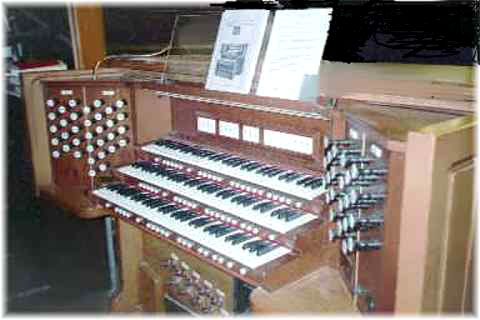
|
New Organ - 2000
|
WELCOME TO A NEW
MEMBER OF ST. JOHN'S
October 2000
In today's
article we want to tell you about the new organ that was installed in
our church this past week. The Rodgers Organ Company in
Hillsboro,
Oregon built the new instrument. Built to American Guild of
Organists
standards, model #950 has three manuals, or keyboards, a full sized
pedal board, and lighted stop tabs and piston push buttons. The
console is a walnut color, and is slightly larger and taller than the
one it replaces. Before it came to St. John's it was involved in
a
week of concerts at Orchestra Hall. The music heard was
Beethoven's
Missa Solemnis.
The new organ, with its digital and MIDI
technology, allows for multiple voices and effects, thus allowing the
organist to create various performance or musical styles. It also
allows the organ to make the various wind effects heard on pipe
instruments. Each note of every stop can be tuned by itself, and
the
entire electronic portion can be tuned to the existing pipes.
This and
a "re-tuning" ability of the organ allow for coordination between the
two parts of the instrument (pipe and electronic).
The new organ
also incorporates software technology as found on computers.
This
will allow each organist to not only store their individual choices for
sounds, but can also re-create their actual playing styles. All
such
information can be stored on regular computer floppy disks. For
all
interested, the new organ, as well as other interesting information,
can be viewed on the Internet at www.rodgersinstruments.com.
At
the present time our new instrument will incorporate only the pipes in
the Great manual (the pipes on the right side of the organ loft, as you
face it). The other pipes will remain in place, but will remain
silent
for now. In the years to come plans call for the complete
restoration
of the existing pipe portion of the organ, and their connection to the
new instrument. This will produce a most wonderful and unique
instrument that will praise God for years to come, and be a wonderful
part of our parish.
Deacon Ron and Mary Smisek
|
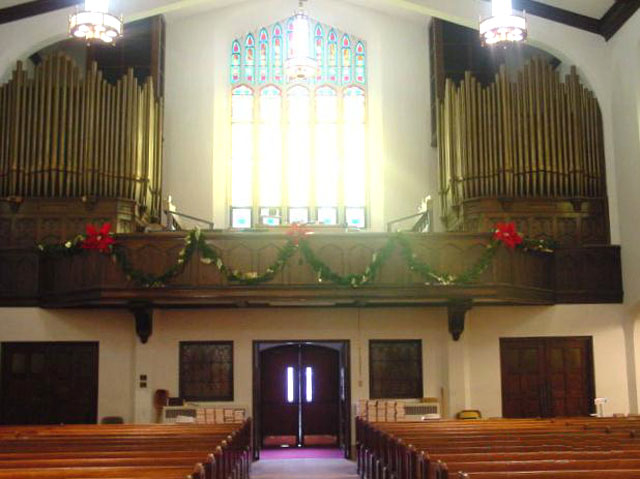
|
Choir Loft
|
|

|
|
|

